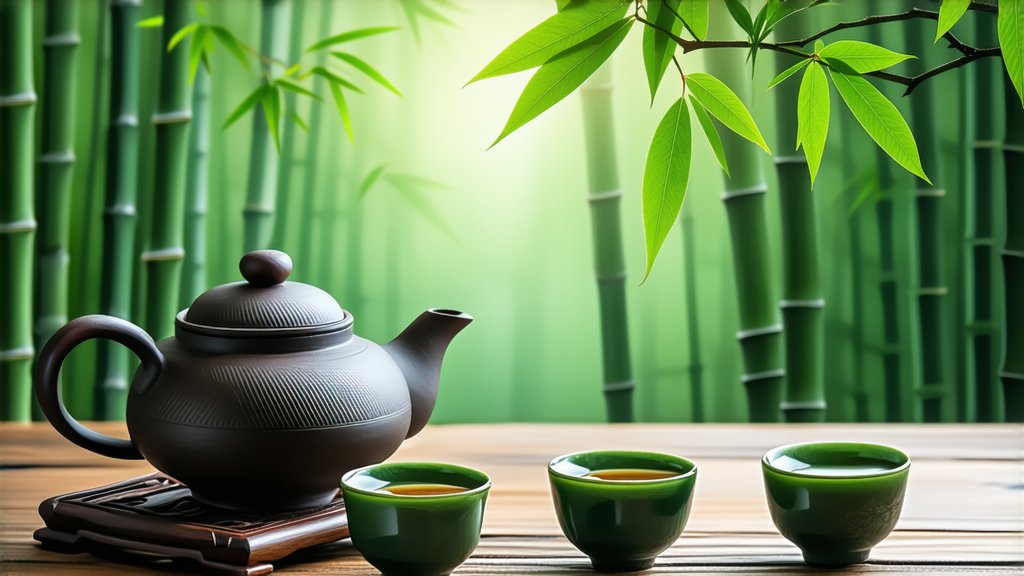
In the vast and diverse landscape of Chinese tea culture, Tieguanyin stands as a paragon of elegance and complexity within the oolong tea category. This exquisite variety, hailing from the lush mountains of Anxi County in Fujian Province, has captivated tea enthusiasts worldwide with its unique flavor profile and rich heritage. Join us on a journey to explore the history, varieties, meticulous craftsmanship, and artful appreciation of this remarkable tea.
History & Origins
The tale of Tieguanyin is intertwined with that of a devout monk named Wang Hongren, who lived during the Qing Dynasty in the early 18th century. According to legend, Wang discovered a wild tea plant growing beneath a Tieguanyin Bodhi tree (Ficus microcarpa), which he then propagated through grafting onto other tea bushes. This serendipitous encounter led to the creation of a new tea variety named after the sacred tree, symbolizing enlightenment and purity. Over centuries, Tieguanyin evolved into one of the most revered oolong teas, embodying the essence of Chinese tea artistry.
Varieties & Classification
Tieguanyin encompasses several sub-varieties, each distinguished by subtle differences in taste, aroma, and appearance. Among them, the most celebrated include:
- Xiang Xing (Fragrant Type): Known for its high floral fragrance, this type showcases notes of orchid, magnolia, or osmanthus, reminiscent of a spring garden in full bloom.
- Yan Xiang (Steeped Fragrance): With a more robust character, Yan Xiang offers a deeper, more complex aroma that reveals itself gradually as the tea infuses, often described as having hints of roasted nuts or caramelized sugar.
- Carbonized Tieguanyin: This variant undergoes additional roasting, imparting a smoky, toasty quality that balances the inherent sweetness and freshness of the tea.
Craftsmanship & Production
The making of Tieguanyin is an intricate dance between man and nature, requiring skillful hands and a deep understanding of the tea plant. The process begins with careful handpicking of only the youngest leaves and buds, ensuring optimal freshness and tenderness. These are then withered under the sun to reduce moisture content, followed by a series of rolling and shaking steps that initiate oxidation—a delicate balance crucial for developing the tea's distinctive flavor.
Next comes the fixation stage, where the leaves are quickly fried or baked to halt oxidation, preserving their vibrant green color and locking in flavors. Afterward, the tea undergoes multiple rounds of shaping and drying, each step fine-tuning the final product's texture and aroma. Master tea makers employ their expertise to monitor temperature, humidity, and timing precisely, as even slight variations can significantly impact the tea's character.
Appreciating Tieguanyin: The Gongfu Cha Ceremony
To truly savor the depths of Tieguanyin, one must engage in the ancient practice of Gongfu Cha, a meticulous tea ceremony that emphasizes mindfulness and respect for the tea. Here’s a glimpse into this ritual:
- Warm the Teaware: Begin by rinsing your teapot and cups with hot water to cleanse and warm them up.
- Measure & Rinse: Place approximately 5 grams of Tieguanyin into the pot. Give it a quick rinse with boiling water to awaken the leaves, discarding this first infusion.
- Steeping: For subsequent brews, pour hot water (around 90-95°C) over the leaves and let it steep for about 15-30 seconds for the initial infusions, gradually increasing the time for later ones.
- Pour & Savor: Decant the brewed tea into a fairness cup to ensure even distribution before pouring into individual tasting cups. Take small sips, allowing the tea to coat your palate fully, noting its evolving flavors and aromas with each infusion.
Tieguanyin rewards patience and attention; each brew reveals new layers of complexity, from its initial floral and fruity notes to the underlying earthy and mineral undertones. As you progress through multiple steepings, you'll witness the transformation of the leaves, appreciating how the tea's character evolves with each pour.
Conclusion
Tieguanyin is more than just a beverage; it embodies centuries of tradition, philosophy, and artistry. Its cultivation and preparation are testaments to the harmony between human ingenuity and the natural world. By engaging in the Gongfu Cha ceremony, we not only honor this legacy but also open ourselves up to a profound sensory experience that transcends time and place. Whether you're a seasoned tea connoisseur or a curious novice, exploring Tieguanyin promises a journey of discovery into the heart of Chinese tea culture.